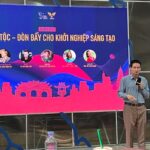This was the focal point of a panel discussion organized by the Center for Vietnam’s Intangible Cultural Heritage (VICH) on the afternoon of November 21 at the Gia Lam Locomotive Factory, part of a series of events for the Hanoi Creative Design Festival 2023.

Associate Professor, Dr. Dinh Hong Hai spoke at the panel discussion.
Among the forum participants were Associate Professor, Dr. Dinh Hong Hai – Head of the Department of Anthropology, Faculty of Anthropology, University of Social Sciences and Humanities, VNU Hanoi; Guest Speaker Dr. Bui Minh Hao; CEO of Vua Dep Lop (King of Tire Sandals) Nguyen Tien Cuong; Designer Vu Thao Giang; CEO of Hanh Silk Luong Thanh Hanh.
Addressing the panel discussion, Assoc. Prof., Dr. Dinh Hong Hai stated, “When it comes to business and economic development, we cannot disregard capital. In reality, we have various types of capital: economic capital, human capital, cultural capital… Among them, ‘cultural capital’ can be broadened to ‘ethnic capital.’ In today’s panel discussion, speakers will discuss the role of cultural capital in fostering creativity.”
Aligned with the theme, the panel discussion delivered scientific insights into “cultural capital” and stories of successful entrepreneurial ventures leveraging “cultural capital.” According to Dr. Bui Minh Hao, the concept of “Cultural Capital” was developed and applied by French sociologist Pierre Bourdieu in sociological research. Since its inception, the concept has been applied, criticized, enriched with new meanings, and has given rise to various approaches and analytical frameworks.

Speakers at the panel discussion
In Vietnam, there has been prior interest from researchers in cultural capital. For instance, Tran Dinh Huou discussed cultural capital as the cultural resources of a nation. Tran Huu Dung divided cultural capital into tangible and intangible cultural capital, viewing cultural capital as a condition and result of human activities that generate and, in turn, influence the development of human life. Dr. Bui Minh Hao interprets cultural capital as tangible and intangible resources, individual or collective expressions that can directly or indirectly participate in economic processes to benefit humans.
While Dr. Bui Minh Hao brought scientific insights to the panel discussion, the shared experiences of the guests served as compelling evidence for culturally-driven entrepreneurial endeavors. One such narrative unfolded with CEO Nguyen Tien Cuong, who recognized the “value and potential” in sandals made from discarded tires, an idea suggested by his father-in-law. He chose to “start up” with this concept, resulting in the successful venture known as “King of Tire Sandals.” Similarly, CEO Luong Thanh Hanh, who built the beloved Hanhsilk brand from the traditional silk-weaving craft of Nam Cao in Thai Binh. Then there’s the story of designer Vu Thao Giang, who left an indelible mark with numerous fashion collections, notably the Ao Dai. With fashion designs infused with the cultural essence of various regions, from materials to patterns, Vu Thao Giang contributed to introducing and promoting the unique values of Vietnamese ethnic culture to fashion enthusiasts both domestically and internationally.

Ms. Nguyen Le Quyen – Director of the Center for Vietnam’s Intangible Cultural Heritage (VICH) spoke at the panel discussion.
According to Dr. Bui Minh Hao, despite operating in different fields, from a researcher’s perspective, the commonality among the three guests is their utilization of ethnic cultural capital to initiate successful entrepreneurial ventures and establish their own brands.
Dr. Bui Minh Hao further emphasizes that in a context where natural resources are rapidly depleting, development based on cultural capital is a crucial direction. Compared to natural resources, cultural capital is more diverse, abundant, and evenly distributed, as almost every community possesses its own cultural capital. Moreover, cultural capital can regenerate more quickly than natural resources. Importantly, economic development stemming from cultural capital is a sustainable trend, as culture itself is the crystallization of interactions between humans and nature and between humans and society over many generations. Therefore, economic development from cultural capital is not just a trend but also a path towards sustainable development.
Dieu Nhi

